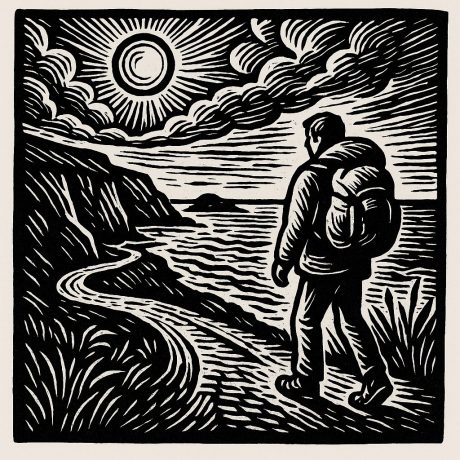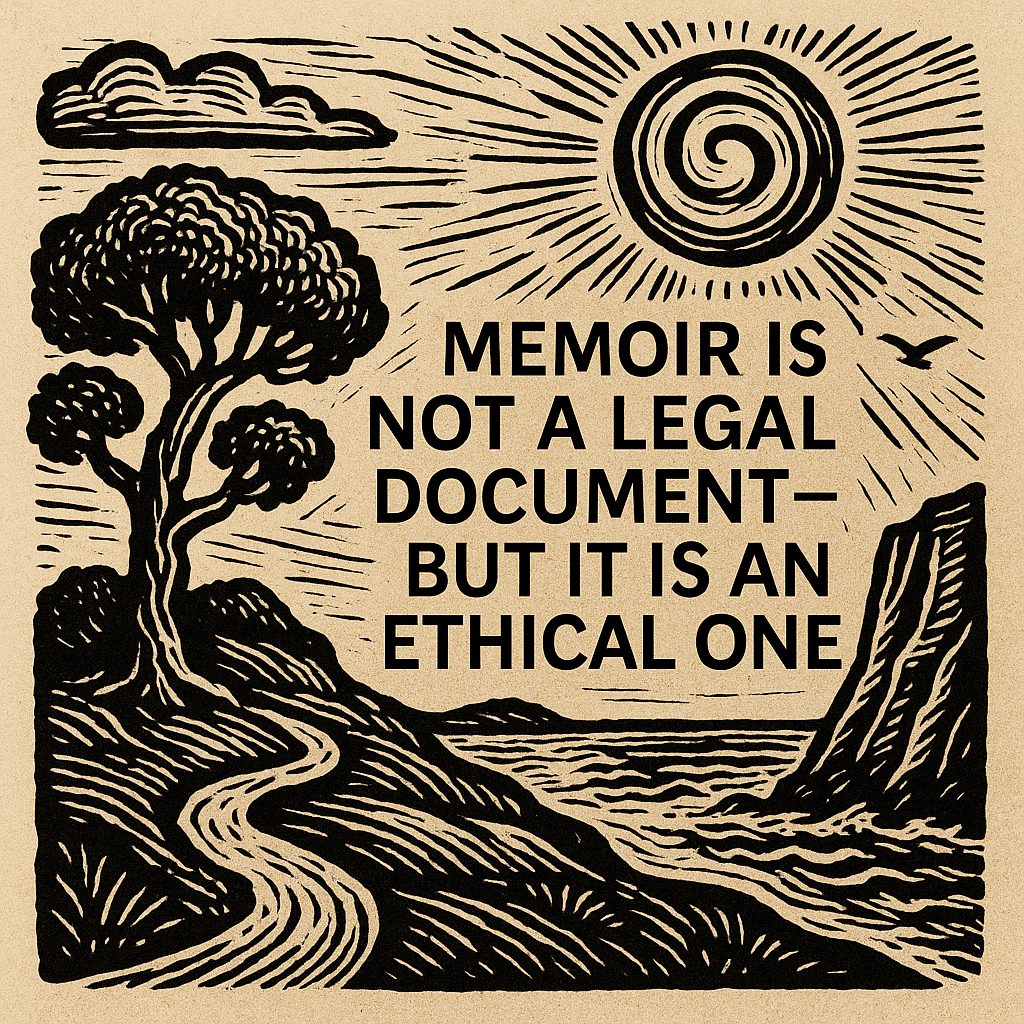
In the wake of The Observer’s recent exposé and the resulting public fallout, Raynor Winn has published a detailed and impassioned defence of The Salt Path, and by extension, her entire literary persona. Her statement—poignant, clarifying, yet also emotionally fraught—deserves careful attention. But for those of us who care deeply about the ethics of memoir, her account raises important questions. Not about whether she and Moth were “really” homeless, but about what kind of truth memoirists owe their readers, and whether Winn’s defence inadvertently confirms some of the ethical complexities I explored in my earlier posts: Ten Ethical Complexities of Memoir, Thirteen Ways of Looking at The Salt Path, and Five Salty Lessons.
Let’s begin by acknowledging that Winn has been on the receiving end of vile abuse, including threats to her family. Nothing justifies that. The line between critique and cruelty must be defended. Winn’s books have moved many readers, including me; they have shed light on hidden experiences, especially of aging, disability, and economic vulnerability. But now, with the release of her personal statement, we are being invited to read the books again—through a clarifying lens. Some fog is lifting. And some new mist is rising.
Memoir Is Not a Legal Document—But It Is an Ethical One
Winn’s central argument is that The Salt Path is a “capsule of time,” not a full account. That’s reasonable. All memoirs are selective. Yet the details now emerging about her past (an out-of-court settlement over embezzlement claims, a ruin in France, debts unpaid or misdirected) aren’t just omitted side stories. They cast retrospective shadows over the entire frame of the book. As I wrote in my earlier blogs, memoir invites a covenant of trust. Even if names are changed, and some things are left unsaid, the ethos of memoir relies on a shared sense that the bones of the story are real, and fairly presented.
What unsettles me most is not that Winn used pseudonyms (many writers do), or even that she restructured events for narrative cohesion. It’s that The Salt Path trades on a symbolic purity that now feels compromised: the righteous couple, wrongfully dispossessed, who find redemption through nature and love. When more complex truths emerge—of legal disputes, past mistakes, perhaps even self-misrepresentation—readers aren’t merely disappointed. They feel deceived.
The Moth Question
Winn’s detailed rebuttal of The Observer’s claims about Moth’s illness is clearly heartfelt. She provides excerpts from medical records (with Moth’s consent), explains the nature of CBS, and powerfully describes how the suggestion that Moth is “faking” has harmed him. This is persuasive and moving. It also raises a subtle question: if the narrative of recovery in The Salt Path is partly symbolic, partly miraculous, and partly literal, what are readers meant to believe?
Winn is adamant that she has never claimed walking “cured” Moth, but it’s also undeniable that the book’s appeal rests on a kind of secular miracle: that the act of walking—weather-beaten, elemental—restores vitality and dignity. This narrative has helped many readers. But now, confronted with medical complexity and terminological shifts (from CBD to CBS), readers might wonder whether the miracle was partly manufactured, not in bad faith, but under the pressures of storytelling.
The Problem of Memoir’s Silences
Some of the most troubling aspects of Raynor Winn’s response lie not in what she disputes, but in what she omits. Her account of the embezzlement allegation made by her former employer, Martin Hemmings, is notably vague. She refers only to “mistakes” made during a “pressured” time, without clarifying what those mistakes were. Although she admits to reaching a legal settlement and paying Hemmings on a “non-admissions basis,” she fails to disclose the sums involved—reportedly tens of thousands of pounds, according to The Observer (Hadjimatheou, 2025). Given that The Salt Path is structured around the idea of losing everything, this financial entanglement is highly relevant. Winn’s omission of both the nature of the allegation and the scale of the settlement leaves readers with a conspicuous narrative gap.
Instead, she carefully separates the Hemmings dispute from the financial events depicted in The Salt Path, insisting that it played no part in the loss of their home and that Hemmings was not the man fictionalised as “Cooper.” These statements may be legally accurate, but they sidestep a deeper narrative and ethical question: if this serious episode involved police investigation, reputational harm, and a substantial financial payout, why was it left out of a memoir that otherwise draws heavily on hardship and adversity for its emotional power?
Equally revealing is her lack of reflection on why this episode was excluded. Even if the book is, as Winn claims, a “capsule of time,” one would expect that such a pivotal, morally ambiguous moment in her recent past might at least be acknowledged as context. Did the experience shape her and Moth’s later vulnerability to “Cooper’s” high-interest loan? Did it affect their understanding of trust, risk, or responsibility? These questions remain unanswered. Instead, we are left with the impression of a narrative carefully pruned to fit a redemptive arc.
Then there is the French ruin—described now as uninhabitable and worthless. It may indeed be of little material value, but it was bought through remortgaging the family home and still constitutes a second property. In a story whose central claim is that the couple had “lost everything,” the existence of even a nominal asset undermines the clarity and emotional resonance of that phrase. It suggests not deceit, but a selective framing designed to reinforce a mythic sense of total dispossession.
In memoir, silence is never neutral. What the writer leaves out—especially when it serves to protect the narrator or simplify a morally messy situation—can shape the reader’s understanding as much as what is included. The power of The Salt Path lies in its appearance of moral clarity and elemental simplicity: nature heals, truth prevails, betrayal is external. But as Winn’s response inadvertently reveals, the real story is far more entangled, legally, ethically, and emotionally. And in those entanglements, some trust may quietly erode.
The Reader as Witness, Not Judge
None of this is to say that Winn set out to deceive. But The Salt Path, like all powerful memoirs, made a bold claim on readers’ sympathy, and in doing so, placed itself within a particular moral register. When that register is recalibrated, even slightly, the whole reading experience changes.
What’s needed now is not public shaming, but an open conversation about how memoir functions in our literary and social lives. Winn’s books are not meaningless because of these revelations. But their meaning has changed. They are now case studies in the complexity of narrative truth, the entanglements of fact and feeling, and the fraught territory where personal redemption stories meet commercial success.
A Call for Memoir 2.0?
Perhaps, in time, Winn might write a sequel: not just another path-walk, but a reflection on what it meant to become an icon, and then be questioned. Such a book could deepen, not diminish, her literary legacy. As I argued in The Mindful Creative Writing Teacher (Gilbert, 2024, p. 172), when writers reflect on their own storytelling processes, especially in memoir, they offer readers not just a life, but a lens.
That’s what I hope we all take from this difficult moment: not a rush to judgment, but a renewed attention to how truth is told, and what it costs.
References
Gilbert, F. (2025) The Mindful Creative Writing Teacher. London: FGI Publishing.


Leave a Reply